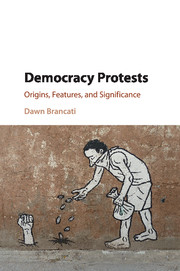Book contents
- Frontmatter
- Dedication
- Contents
- List of Figures
- List of Tables
- Acknowledgments
- 1 Introduction
- 2 Characteristics of Democracy Protests
- 3 Relating Economic Crises to Democracy
- 4 Analyzing the Rise of Democracy Protests
- 5 Analyzing Elections as Trigger Events
- 6 Historical Trends in Government Responses
- 7 Analyzing Political Accommodation
- 8 Historical Trends in Democratization
- 9 Analyzing Democratization
- 10 Conclusion
- Appendix: Data and Measures
- References
- Index
9 - Analyzing Democratization
Published online by Cambridge University Press: 05 September 2016
- Frontmatter
- Dedication
- Contents
- List of Figures
- List of Tables
- Acknowledgments
- 1 Introduction
- 2 Characteristics of Democracy Protests
- 3 Relating Economic Crises to Democracy
- 4 Analyzing the Rise of Democracy Protests
- 5 Analyzing Elections as Trigger Events
- 6 Historical Trends in Government Responses
- 7 Analyzing Political Accommodation
- 8 Historical Trends in Democratization
- 9 Analyzing Democratization
- 10 Conclusion
- Appendix: Data and Measures
- References
- Index
Summary
In this chapter, I analyze the conditions, if any, under which democracy protests are associated with democratization – including full-scale democratic transitions as well as more modest democratic reforms. In this analysis, I focus, in particular, on the relationship between numbers of protesters and democratization, expecting that protests attracting more participants pose a greater threat to governments than protests attracting fewer participants, and are more likely to be associated with democratization as a result. Economic crises, in this context, are indirectly related to democratization because crises, as previous analyses have shown, are associated with larger protests. The statistical analysis does not capture instances where democracy protests repel threats to democracy and maintain the status quo, as in cases of coups d'etat or autogolpes.
The statistical analysis covers 180 countries over a twenty-three-year period between 1989 and 2011. Consistent with the findings on accommodation in Chapter 7, the statistical analysis in this chapter shows that governments are more likely to undergo democratic transitions the year after democracy protests occur the more participants protests include. However, they are not significantly more likely to undertake democratic reforms. Other factors, potentially affecting the extent to which protests pose a threat to governments, including the tactics and demands of the protests, as well as the level of economic inequality or degree of capital mobility in countries, are not significantly associated with democratization.
THE SIZE OF DEMOCRATIZATION
In the post–Cold War period, democratic transitions, but not democratic reforms, occurred more often among larger protests. Figure 9.1 depicts the percentage of protests of a given size that were followed by either democratic transitions or democratic reforms within one year of the protests for the period between 1989 and 2011. As this figure illustrates, the percentage of protests for which democratic transitions occurred within one year of the protests is increasingly higher for protests including more participants, with the exception of protests attracting a million or more people at their single largest rally. Democratic transitions did not occur within one year of any protest including a million or more participants, but there was only one protest of this size that occurred between 1989 and 2011 coded by the polity index – the 1989 Tiananmen Square protests in China.
- Type
- Chapter
- Information
- Democracy ProtestsOrigins, Features, and Significance, pp. 159 - 175Publisher: Cambridge University PressPrint publication year: 2016



